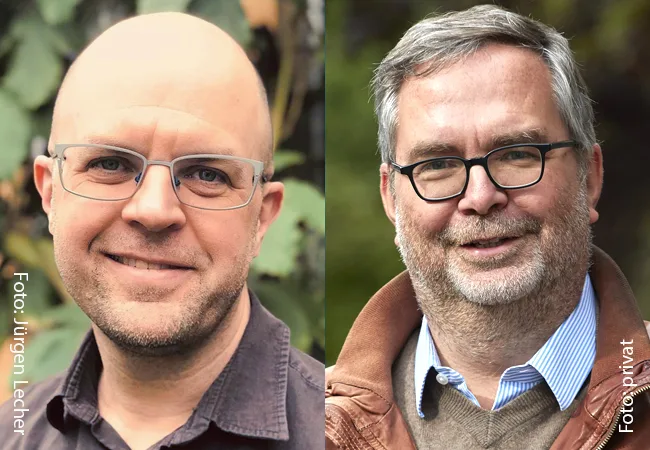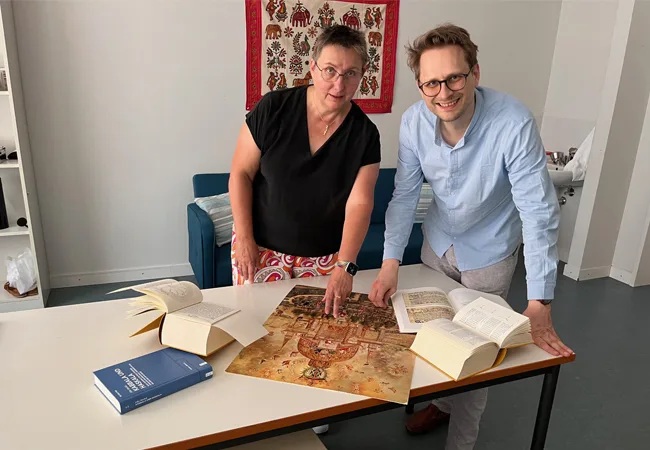Together, mathematician Jochen Blath and US-American biologist Jay T. Lennon are investigating something known as “dormancy” in living organisms. Thanks to a Humboldt Research Award, Lennon is now spending six months in Frankfurt.

Essentially, it comes down to the same thing each time: When Bacillus anthracis, the pathogenic bacterium that causes anthrax, forms robust and extremely resistant spores inside itself, which in their dormant state can endure conditions for tens of thousands of years that Bacillus anthracis would not be able to survive. Or when “honesty”, an annual plant of the genus Lunaria, produces seeds some of which germinate with a certain time delay – not the following year, as would usually be expected, but the one after that at the earliest. When Female crustaceans of the genus Daphnia, which normally reproduce asexually, first produce males and then resting eggs when under stress.
When intestinal bacteria of the genus Bacteroides are able to switch between their active and dormant states without forming additional physical structures. When hedgehogs and marmots hibernate. Likewise, when tiny water bears (phylum Tardigrada) switch to their dormant state, which allows them to survive even in hostile space, such as on the outer shell of the International Space Station (ISS).
As different as the individual strategies of many living organisms might appear, they all have one thing in common: There are times when their metabolism shuts down almost completely and there is no further interaction between the organism and its environment. “These are dormancy strategies,” says US-American biologist Jay T. Lennon from the University of Indiana in Bloomington.
“The tree of life, which maps the phylogenetic relationships of all living organisms – be they animals, plants, microbes, or other types of organism – is an important example of ‘convergent evolution’,” Lennon explains. “What this means is that numerous species have developed dormancy strategies independently of each other.” He has been studying dormancy phenomena for almost 15 years and working, since 2019 especially, with mathematician Jochen Blath, who became a professor at Goethe University Frankfurt in 2022. Having received a Humboldt Research Award from the Alexander von Humboldt Foundation, Lennon is currently spending six months as a researcher in Blath’s working group.
Survival strategy
“For an organism, developing a dormancy strategy firstly requires a great deal of effort. In a way, it incurs high ‘costs’ because it is permanently obliged to make resources available for necessary ‘reorganization measures’. But this ultimately pays off because it helps ensure the survival of the species in the long term,” says Blath, pointing to the example of plants that, despite there being ideal ambient conditions, delay the germination of their seeds by one or more years. They do so because, if adverse circumstances such as fire or drought were subsequently to destroy the plant population, new plants could grow from the remaining seeds in later years. “In this way, the seeds whose germination was delayed, or in general the dormant part of a population, form a kind of ‘genetic reservoir’,” Lennon adds.
As a biologist, Lennon has studied how many different species of living beings form part of the “genetic reservoir” of a system of organisms, and how frequently the species occur in each case. As a mathematician, Blath has modelled how the switching mechanism (e.g. “Spontaneous or induced by certain stimuli?” or “Coordinated or each organism independently?”) affects a dormancy system in the long term. Both scientists have been dealing extensively with the structure of such “genetic reservoirs” since their collaboration first began in 2019, when Blath, together with other mathematicians, organized a workshop on “dormancy” (a topic new to him at the time) and invited Lennon as an expert on its biological principles.
Interaction of different subject cultures
“Already back then I admired the panache with which Jay, as a biologist, stood in front of a room full of mathematicians and patiently answered all our amateurish biology questions,” Blath recalls. At the same time, Lennon did not shy away from inquiring in detail about mathematical correlations. He, too, is equally enthusiastic about working with Blath and stresses that their shared interest in dormancy more than compensates for their different professional backgrounds, correspondingly different approaches, and the different subject cultures in their everyday academic lives: “These synergies are fascinating,” remarks Lennon.
As part of a collaborative project with Dutch, US-American and German partners, Lennon and Blath initially worked out how a system consisting of individuals that interact with each other in a simple way (where simple parameters might be A eats B, C and D produce offspring E and F, etc.), and where simple parameters exist between active and dormant states, can result in an extremely complex behavior on the part of the entire system: “At the level of entire populations and over long periods of time, many phenomena are the result of simple rules at the micro level that are immensely exciting for us as mathematicians dealing with stochastic processes,” explains Blath, adding that “this means that small differences in reproductive behavior might lead to other traits developing in a large population or to this population dying out sooner or later or not at all.”
Lennon and Blath have planned to bring dormancy researchers together again in a second workshop – this time at Goethe University Frankfurt in December 2023. However, Blath emphasizes that the event will not be a repeat of a single biologist encountering an entire group of mathematicians, but rather one where “mathematicians will come together with roughly the same number of researchers from other scientific disciplines to identify concrete areas where dormancy phenomena occur.” Lennon adds: “An agenda for our research work is already taking shape that is chock full for at least the next ten years.”
During the workshop, Blath and Lennon intend to discuss dormancy phenomena in four areas: “Statistical Physics”, “Population Genetics and Evolution”, “Ecology and Biodiversity” as well as “Medicine”. One field of application that could potentially be particularly attractive for the application of mathematical descriptions of dormancy phenomena, Blath says, is infectiology and oncology (cancer research): It is presumed that the pathogens of a chronic infection switch temporarily to the dormant (= inactive) state and there is then no further interaction between the pathogenic germ and its environment. In such a state, even an antibiotic no longer has any effect. Something similar occurs when cancer cells enter the dormant state and chemotherapy ceases to be effective as a result. “That is why we want to create mathematical models of cell populations that contain both active and dormant cancer cells,” says Blath, pointing out that this might help make treatment plans more effective.
In this respect, it is primarily dormancy research that will benefit from the Humboldt Research Award for Jay T. Lennon. After all, it is enabling Blath and Lennon to work much more closely together: Meeting in person, for instance, and no longer online, now that their offices are just six floors – not 8,500 kilometers – apart.
Stefanie Hense












